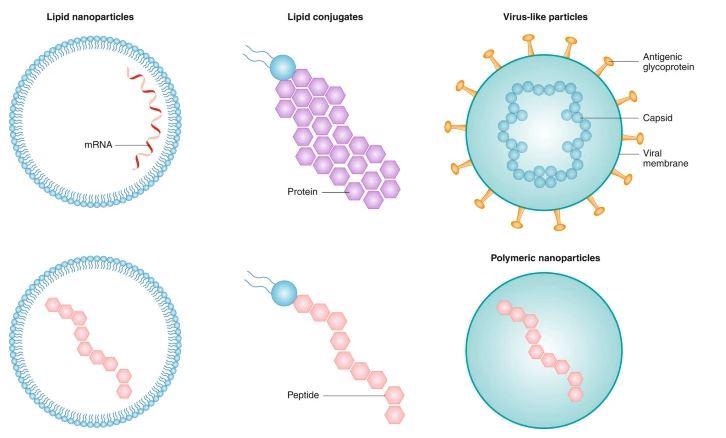 Image Credit: https://doi.org/10.1038/s41565-020-0732-3
Image Credit: https://doi.org/10.1038/s41565-020-0732-3
A COVID-19 vaccine — or two — is just around the corner, bringing with it the possibility of a return to normalcy for many people. These medical interventions use nanotechnology to mimic nature’s own method of slipping past the immune system to deliver treatment to target cells.
Whilst the world went on lockdown, researchers worldwide were in labs drafting nanotechnology into the COVID-19 battle. Taking their inspiration from a remarkable 2018 drug, they strived to deliver safer, more easily administered vaccines, and medical technology not just to fight COVID-19, but also any future potential pandemics. These vaccines are built upon advances in nanotech and the delivery of messenger RNA (mRNA) to target cells. The development of these applications predates the current crisis and offers an avenue to safer and more effective future treatments.
Vaccines that employ mRNA were in early development before COVID-19 brought the world to its knees, and nanotech has been central to these efforts — unsurprisingly, as viruses are just naturally occurring nanoparticles themselves.
The key to making effective nanoparticle vaccines, and medicines in general, lies in mimicking the natural behaviors and tricks that make viruses so successful, and dangerous, in the first place.
Tackling COVID-19 with Nanotech
On November 18th 2020, BioNtech and Pfizer announced the final results of their COVID-19 vaccine phase 3 clinical trial of BNT162b2. This followed an announcement earlier that month by Cambridge-based company, Moderna, of the preliminary outcome of another phase 3 study of an alternative vaccine mRNA-1273 to combat the virus.
One of the most pressing issues in drug and vaccine development is creating treatments that can evade the body’s natural defense mechanisms and reach target cells undamaged and this has been no different in the quest for a COVID-19 solution. This ‘direct delivery’ approach wouldn’t just result in more effective treatment, but would also reduce potentially harmful side-effects, thus a safer drug. The answer to this problem, it seems, lies in understanding the methods nature has already devised to give these systems the slip.
Both BNT162b2 and mRNA-1273 use the same method to avoid the body’s natural defense mechanism as strands of mRNA — a genetic messenger that transcribes DNA code into proteins — do. This system allows them to deliver a medical payload to target cells without being degraded or destroyed. And it seems to work. Both the drugs are reported to show efficacy in infection prevention of around 95%.
A new paper published in Nature highlights the fact that whilst both vaccines still await approval by the Food and Drug Administration (FDA), they “scream innovation” as they will likely mark the first such mRNA-based interventions of this kind approved for clinical use.
Yet, despite standing on the cusp of being the first vaccines that use liposomal nanoparticle delivery system to be approved, they won’t be the first medicine approved by the FDA that uses that method.
The vaccines mentioned above follow in the footsteps of Onpattro, a medicine pioneered by Alnylam Pharmaceuticals in 2018 when they took Nobel-prize winning research and created the first siRNA drug.
Infiltrating the Body
Onpattro — which is designed to help patients with an inherited neurological condition — packages small molecules of interfering RNA in lipid nanoparticles. These are the same fatty molecular envelopes that help mRNA slip past biological ‘gatekeepers’ and inspires the mechanism about to be widely used to battle COVID-19.
The drug, and the vehicle it uses to deliver treatment were approved by the FDA in 2018 and discussed in a 2019 paper published in Nanoscale Communications.
In the case of the two new vaccines, the nanocarrier system fights COVID-19 by delivering mRNA to cells triggering the production of antigens and influencing the immune system to start creating antibodies. This results in an immune system reaction that combats the virus and thus prevents the development of the disease.
The technique used by these mRNA, that kick-starts the body’s own cellular protein-making properties differs substantially from the methods used by more ‘traditional’ vaccines. These earlier approaches mimic a virus and trick the immune system into building defenses against it for future use should it encounter the infection again.
In the future, these mRNA vaccines could be delivered in more advanced ways, such as in patches containing microneedles or via slow-release implants.
There’s no mistake both the BNT162b2 and mRNA-1273 vaccines are a huge breakthrough of molecular medicine and biotech. But more than this, as Daniel Anderson, professor of chemical engineering at the Massachusetts Institute of Technology, points out that all three medicines built on a nanotech platform, prove that nanoparticle drug delivery isn’t just a curious research avenue but can be translated into approved and successful vital medical interventions.
In my mind, one of the heroes in this story is the RNA nanoparticle, because siRNA led to mRNA vaccines.
Dr. Daniel Anderson, Professor of Chemical Engineering, Massachusetts Institute of Technology
Sources and Further Reading
‘Nanomedicine and the COVID-19 vaccines’, Nature Nanotechnology, (2020), https://doi.org/10.1038/s41565-020-00820-0
Kulkarni. J. A., Witzigmann. D., Leung. J., et al, (2020), Nanoscale Communication, DOI: 10.1039/c9nr09347h
Shin, M.D., Shukla, S., Chung, Y.H., et al, ‘COVID-19 vaccine development and a potential nanomaterial path forward,’ Nature Nanotechnology, (2020). https://doi.org/10.1038/s41565-020-0737-y
Disclaimer: The views expressed here are those of the author expressed in their private capacity and do not necessarily represent the views of AZoM.com Limited T/A AZoNetwork the owner and operator of this website. This disclaimer forms part of the Terms and conditions of use of this website.